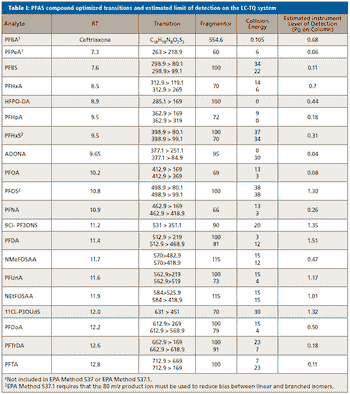
Untargeted GC–MS metabolomics with sample derivatization is shown here to be effective for measuring the chemical profiles of traditional and plant-based meat products.

Untargeted GC–MS metabolomics with sample derivatization is shown here to be effective for measuring the chemical profiles of traditional and plant-based meat products.

This method for PFAS analysis in milk and infant formula is robust, reliable, and reproducible, with scope to expand the list of PFAS in the future.

This method for PFAS analysis in milk and infant formula is robust, reliable, and reproducible, with scope to expand the list of PFAS in the future.

A method is described using a triple quadrupole LC–MS instrument with isotopic dilution to obtain the highest accuracy and confidence for analysis of per- and polyfluoroalkyl substances (PFAS) in water. Excellent method spike recoveries and robustness were found in wastewater.

Per- and polyfluoroalkyl substances (PFAS) are found in firefighting foams and consumer products. They are ubiquitous in the environment and are an emerging human health concern. This work compares the 2009 and 2018 revised US Environmental Protection Agency (EPA) LC–MS/MS methods of analysis for PFAS in drinking water.

Per- and polyfluoroalkyl substances (PFAS) are chemicals found in fire‑fighting foams and consumer products requiring water-resistant and stain-repellent properties. As a result of their unique chemical properties and long‑term widespread usage, these chemicals are an emerging human health concern. US Environmental Protection Agency (EPA) released analytical methods for PFAS measurement in 2009 and most recently in November of 2018. In this article, data generated using these methods with allowed analytical modifications is presented and demonstrates robustness and reproducibility while achieving low level detection limits in drinking water.

A 12-minute analytical method was developed for 122 VDs in meat. The method uses Agilent All Ions MS/MS on a Q-TOF LC/MS instrument along with the Agilent Veterinary Drugs PCDL.

Published: July 1st 2022 | Updated:

Published: December 1st 2022 | Updated:

Published: July 1st 2022 | Updated:

Published: May 27th 2016 | Updated:

Published: May 8th 2019 | Updated:

Published: October 1st 2019 | Updated: